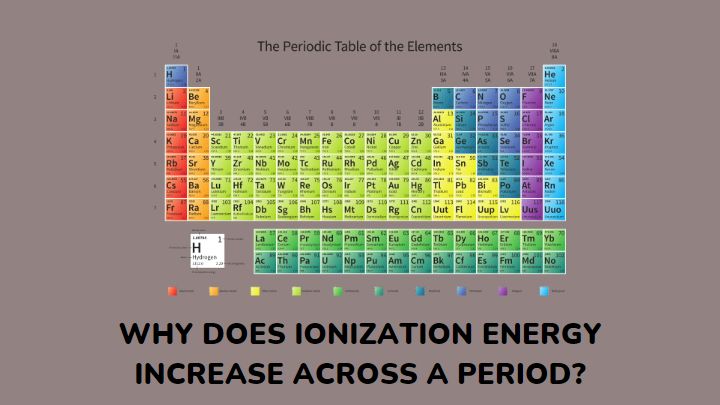Ionization energy (IE) is a periodic trend that will increase across the period and decrease down a group. Periodic trends are dependent on several factors such as the number of energy levels, shielding effect, and number of protons in the nucleus.
These trends have direct or inverse proportionality to these factors. Ionization energy is the focus of this article. I’ll be discussing why it increases across the period and decreases down the group.
Additionally, this article highlights the factors that cause the increase of ionization energy across the period.
What is ionization energy?
The ionization energy of an atom, ion, or molecule is the lowest energy required to remove the most loosely bound electron of that atom, ion, or molecule.
It refers to the minimum energy required to get an element to be a part of a chemical reaction that involves the donation or formation of electrons.
The unit of ionization energy is kilojoules per mole (kJ/mol) or kilocalories per mole (kcal/mol) in chemistry. In physics, it is electronvolts (eV) or Joules (J).
Furthermore, ionization energy occurs in succession and is called 1st ionization energy, 2nd ionization energy, 3rd ionization energy, etc.
The 1st ionization energy is the energy required to remove the first and most loosely bound electron, the 2nd IE is the energy required to remove the second electron, and the 3rd IE is the energy needed to remove the third electron.
Ionization energy is best described with the following reactions:
Suppose A is an element:
A ⟶ A+ + e− (1st ionisation energy)
A+ ⟶ A2+ + e− (2nd ionisation energy)
A2+ ⟶ A3+ + e− (3rd ionisation energy)
Why does ionization energy increase across a period?
Ionization energy increase across a period as the nuclear charge increases and atomic size decreases.
As the charge of the nucleus increases, there are also more protons, and they are more tightly bound, thereby requiring more enthalpy for dissociation.
Also, as atomic size decreases, the outermost electrons draw closer to the nucleus. It is more difficult to remove these electrons because they are held more tightly by the charge of the nucleus.
Why does ionization energy decrease down a group?
Ionization energy decreases down the group as atomic size increases due to an increase in valence shells and electrons.
As the number of filled shells increases down the group, the farther away the outer electrons are from the nucleus. Therefore, they will easily lose these electrons.
What are the factors that affect ionization energy?
Some factors affect ionization energy. They include:
Atomic radius
Ionization energy depends on the distance between the nucleus and the electron. As mentioned earlier, the closer the electron is to the nucleus, the higher the ionization energy. The electrons in larger atoms are held less tightly to the nucleus.
Nuclear charge
The charge on the nucleus also affects the ionization energy of the atom.
When the nuclear charge is high, the attraction between the valence shell and the nucleus is also high. Therefore, it requires more energy to remove an electron from the atom.
Electronic configuration
The electronic configuration has an impact on the ionization energy of an element. Elements with stable electronic configuration are elements with full or half-full shells.
It is harder to take an electron away from a full or half-full shell. Therefore, ionization energy will increase across the period, from left to right, where there are more filled shells.
Shielding effect
Ionization energy decreases with an increasing shielding effect. The inner electrons in the atom shield the outer electrons from the attraction of the nucleus. This is known as the shielding effect.
The higher the shielding effect, the easier it is to pull an electron from the atom.
Penetration power of electrons
When the electron cloud of one electron penetrates the electron cloud of another electron, it creates a phenomenon called the penetration effect.
This effect increases the ionization energy because electrons are closer to the nucleus and will require more energy to be removed.
Is ionization energy the same as the first ionization energy?
Yes, it is. First ionization energy is the initial amount of energy required to remove the first electron from a neutral atom.
Does second ionization energy also increase across the period?
Yes, the second ionization energy also increases across the period.
FAQs
Why do electronegativity and ionization energy increase across a period?
Electronegativity and ionization energy are directly related to nuclear charge, atomic number, and number of protons. Therefore, they follow similar periodic trends.
What is the relationship between ionization energy and atomic size?
The ionization energy of an atom is inversely proportional to the atomic size of that atom. The ionization energy increases as the atomic size decreases.
Why do alkali metals have low ionization energy?
The alkali metals are the group IA metals, and they have low ionization energies. This is because of the large size of their atoms and the electronic configuration of their valence shell.
Due to these factors, these metals easily lose the single electron in their outermost shell and attain the nearest noble gas configuration.
What other periodic trends increase across the period?
Electron affinity and electronegativity also increase from left to right across the period as nuclear charge increases and atomic size decreases.
Conclusion
Ionization energy increases across the period with an increase in the number of protons and nuclear charge.
As the number of protons and atomic number increases, the elements across the period (left to right) will require more energy to remove the most loosely bound electron of a gaseous atom, ion, or molecule.
Finally, learn about the periodic trend of Zeff.
Thanks for reading.
